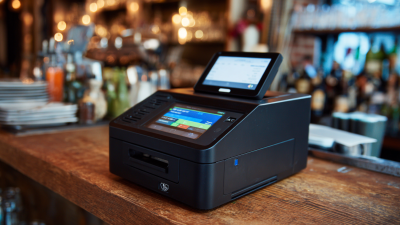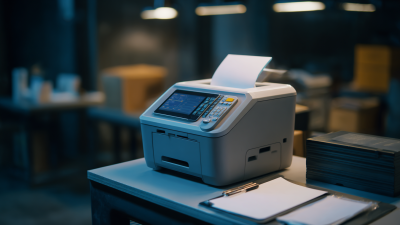In today's fast-paced business environment, the efficient management of inventory and data tracking has become a cornerstone for operational success. According to a recent report by Zebra Technologies, 83% of businesses utilize barcodes to enhance their efficiency in inventory management, demonstrating the critical role that printing barcodes plays in streamlining operations. The ability to accurately print barcodes not only facilitates quicker checkouts and improved customer satisfaction but also significantly reduces errors in stock-taking processes.

Furthermore, a study by IDTechEx reveals that the barcode label market is projected to grow by over 4% annually, indicating an increasing reliance on barcode technology across various industries. As businesses strive to remain competitive, understanding the nuances of effectively printing barcodes is essential for maintaining accurate records and optimizing workflows. This guide will delve into the best practices for printing barcodes that cater specifically to your business needs.
When selecting the right barcode type for your business needs, it's crucial to understand the various types and their applications. The most common barcode formats include UPC, QR codes, and Code 128. UPC barcodes are primarily used for retail products, allowing for quick scanning at the point of sale. According to industry reports, 93% of consumers prefer shopping at stores that utilize barcode scanning for efficient checkout. On the other hand, QR codes have gained traction in recent years, especially for mobile marketing and customer engagement. They can link to websites, promotional content, or even track customer analytics, with a report from Research and Markets indicating that the global QR code market is expected to reach $25 billion by 2027.
Choosing the right barcode type also involves considering the specific use case within your operations. For example, if your business relies heavily on inventory management, Code 128 is an ideal choice because of its ability to encode a wide range of alphanumeric characters efficiently. A study from Zebra Technologies highlighted that the implementation of barcoding can reduce operational costs by up to 30% and improve accuracy in inventory tracking by as much as 90%. With the right barcode system, businesses can streamline operations, enhance customer experiences, and ultimately drive growth.
When it comes to printing high-quality barcodes for your business needs, selecting the right equipment is crucial. The choice of printer can significantly impact the durability and scannability of your barcodes. There are primarily two types of printers to consider: thermal transfer and direct thermal printers. Thermal transfer printers use a ribbon to create long-lasting prints, making them ideal for barcodes that require longevity. Direct thermal printers, on the other hand, are more suited for short-term use, as the printed label can fade over time.
Tips: Ensure that your printer has a suitable resolution; a minimum of 300 dpi (dots per inch) is recommended for sharp barcodes. Additionally, test different barcode formats and sizes to find what works best for your products.
Apart from the printer, selecting the correct labels is equally important. Labels come in various materials and finishes, and the right choice depends on your application. For instance, if you need barcodes that will be exposed to moisture or chemicals, waterproof synthetic labels are ideal.
Tips: Always perform a test print before mass production to check for clarity and readability. This simple step can save you time and prevent costly mistakes. Investing in high-quality equipment and materials will ensure that your barcodes are effective and reliable.
This bar chart illustrates the effectiveness ratings of essential equipment factors needed for high-quality barcode printing. Each factor has been rated based on its contribution to the overall performance of barcode printing operations.
When designing barcodes for your business, compliance with industry standards is crucial for ensuring smooth distribution and tracking of your products. Barcodes are unique identifiers that serve as essential tools in product management, acting as the 'identity' and 'pass' for items in the market. Following the guidelines set by the international organization of barcode standards is vital.
For example, the standard barcodes include formats composed of 8, 12, 13, or 14 digits, which help streamline inventory and enhance traceability.
Moreover, ensuring visibility and legibility of barcodes is essential, as it facilitates quick scanning and minimizes errors during transactions. Businesses should prioritize the quality of barcode prints, using durable materials resistant to wear and tear, especially for products that will be on store shelves for extended periods.
Implementing best practices in barcode design not only complies with industry regulations but also enhances overall operational efficiency and customer satisfaction.
 When selecting materials for barcode labels, businesses should prioritize
durability and compatibility with their printing methods. Common label materials
include paper, polyester, and vinyl, each offering distinct advantages. Paper labels are cost-effective and ideal for
short-term use, while polyester and vinyl
provide superior durability and resistance to environmental factors such as moisture and chemicals. It's essential to assess the
intended application and environment when choosing the right material to ensure the barcode remains legible over time.
When selecting materials for barcode labels, businesses should prioritize
durability and compatibility with their printing methods. Common label materials
include paper, polyester, and vinyl, each offering distinct advantages. Paper labels are cost-effective and ideal for
short-term use, while polyester and vinyl
provide superior durability and resistance to environmental factors such as moisture and chemicals. It's essential to assess the
intended application and environment when choosing the right material to ensure the barcode remains legible over time.
Equally important is the choice of ink used for printing barcodes. The ink must be compatible with the label material to prevent
smudging and ensure a crisp, clear print. For thermal transfer printing,
using resin-based inks is advisable as they adhere well to
synthetic materials and resist abrasion. Meanwhile, for direct thermal printing,
choosing labels designed for this method can enhance readability and longevity. Ultimately, careful selection of both label
material and ink helps maintain the integrity of barcodes, which is crucial for efficient inventory
management and customer transactions.
When it comes to printing barcodes, businesses often encounter a range of challenges that can hinder their efficiency. One common issue is the quality of the prints. Low-quality barcodes can lead to scanning errors, which may disrupt the workflow. To tackle this problem, it is essential to invest in high-resolution printers and use the appropriate barcode labels. Ensuring that your printer settings are correctly configured to match the barcode design is also crucial, as even minor discrepancies can lead to scannability issues.
Another frequent challenge is the alignment of barcodes on products or packaging. Misalignment can result from improper setup during the printing process or from moving products too quickly through the labeling station. To address this, you should conduct regular checks on your printing alignment and adjust the settings as necessary. Using guides or jigs during the application process can also help maintain consistency and improve overall barcode placement, ensuring that your barcodes are correctly positioned for optimal scanning performance.







